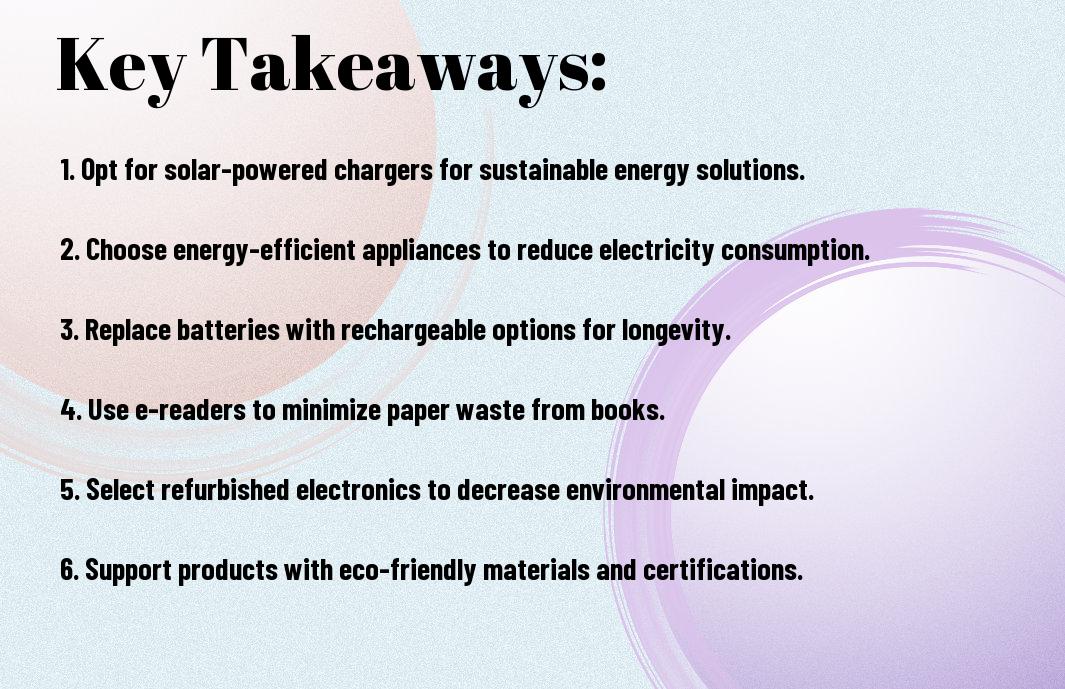As you consider reducing your environmental footprint, you’re likely thinking about replacing your everyday electronics with more sustainable options. You want to make a positive impact on the planet, and your choices can make a difference. Your daily habits, from charging your phone to listening to music, can be transformed with eco-friendly alternatives. You can start by exploring green substitutes for your routine devices, and this post will guide you through the best options available, helping you make informed decisions for a more sustainable future.
Key Takeaways:
To reduce our environmental footprint, it’s imperative to consider sustainable alternatives to everyday electronics. Here are the key points:
- The recycling of old electronics is an effective way to reduce electronic waste, and many companies now offer trade-in programs for old devices, which can be exchanged for discounts on new, more energy-efficient models.
- Using rechargeable batteries instead of disposable ones can significantly decrease the amount of waste generated by households, and investing in solar-powered chargers can further reduce our reliance on non-renewable energy sources.
- Opting for refurbished or second-hand electronics is another eco-friendly alternative, as it reduces the demand for new, resource-intensive devices and helps to decrease the amount of electronic waste in landfills and oceans.


Sustainable Smartphones
To make a positive impact on the environment, you can opt for sustainable smartphones made with eco-friendly materials and designed with energy efficiency in mind. This can significantly reduce your carbon footprint and contribute to a more sustainable future.
Eco-Friendly Materials
On the topic of sustainability, many phone manufacturers are now using recycled materials in their products, allowing you to reduce your environmental impact. You can look for phones made with recycled metals, bioplastics, or sustainably sourced materials.
Energy Efficiency
For a more energy-efficient option, you can choose smartphones with power-saving features, such as low-power modes or energy-harvesting technologies, which can help minimize your phone’s energy consumption.
Materials used in energy-efficient smartphones are designed to minimize waste and reduce the amount of energy required to manufacture and charge your device. You can consider phones with longer battery life, which can reduce the need for frequent charging, and look for devices with environmentally friendly charging solutions, such as solar-powered chargers or wireless charging pads, to further minimize your environmental impact.
Green Computing
It is vital to consider the environmental impact of your computing habits, and one way to do this is by adopting green alternatives to traditional electronics. You can reduce your carbon footprint by using energy-efficient devices and sustainable practices.
Low-Power Laptops
Around the world, manufacturers are now producing low-power laptops that consume less energy without compromising performance, allowing you to work or browse the internet while reducing your energy consumption.
Sustainable Desktops
Along with laptops, sustainable desktops are also becoming increasingly popular, offering you a more environmentally friendly option for your home or office computing needs, with features such as energy-efficient processors and recyclable materials.
In fact, when choosing a sustainable desktop, you should look for certifications such as Energy Star, which ensures that the device meets energy efficiency standards, and consider the overall lifecycle of the product, from production to disposal, to minimize your environmental impact.
Alternative Energy Sources
Not relying on traditional energy sources, you can reduce your carbon footprint by exploring green alternatives. You’ll find that switching to renewable energy is easier than you think.
Solar Power
Around the world, solar power is becoming increasingly popular as a clean energy source. You can harness the sun’s energy to power your home and electronics, reducing your reliance on non-renewable energy.
Wind Energy
Another option you have is to utilize wind energy, which can be harnessed using wind turbines. You can install them in your backyard or invest in a community wind project, reducing your energy bills and carbon emissions.
Solar energy aside, wind energy is another viable option for you to consider, as it can generate significant amounts of power. You’ll be supporting a sustainable future by investing in wind energy, and you can even store excess energy for later use, making it a convenient choice for your daily needs.
Eco-Friendly Gadgets
For those looking to reduce their environmental footprint, eco-friendly gadgets are a great place to start. You can find sustainable alternatives to everyday electronics, from tablets to smartwatches, that are designed with the planet in mind.
Green Tablets
Beneath the surface of traditional tablets, you’ll find a range of eco-friendly options that offer similar performance without the environmental harm. You can choose from tablets made with recycled materials, energy-efficient designs, and sustainable manufacturing processes.
Sustainable Smartwatches
Across the market, you’ll find a variety of sustainable smartwatches that combine style with eco-friendliness. You can opt for watches made from recycled materials, powered by solar energy, or designed for longevity to reduce waste.
Green technology is at the forefront of sustainable smartwatches, allowing you to track your fitness goals while also reducing your carbon footprint. You can choose from a range of eco-friendly smartwatches that prioritize sustainability without sacrificing performance, making it easy to make a positive impact on the environment with your purchasing decisions.
Innovative Designs
Once again, you’ll find that eco-friendly electronics are not just about reducing waste, but also about innovative designs that minimize environmental impact. You can choose from a variety of sustainable gadgets that are both functional and stylish.
Biodegradable Materials
Designing products with biodegradable materials is a key aspect of green electronics. You can opt for devices made from natural materials that can easily decompose, reducing electronic waste and minimizing harm to the environment.
Minimalist Approach
Before making a purchase, consider a minimalist approach to your electronics. You can choose devices with simple designs that use fewer materials and components, reducing waste and energy consumption.
A closer look at the minimalist approach reveals that it’s not just about simplicity, but also about efficiency. You can benefit from devices that are designed to last longer, with replaceable parts and recyclable materials, allowing you to reduce your electronic footprint and make a positive impact on the environment.
Environmental Impact
Now that you’re considering switching to green alternatives, you’ll be reducing your environmental footprint. Your daily choices can significantly impact the planet, and opting for eco-friendly electronics is a great start.
E-Waste Reduction
Decreasing the amount of electronic waste is a significant benefit of choosing green alternatives. You’ll be minimizing your contribution to the growing problem of e-waste, which is harmful to the environment and human health.
Carbon Footprint
Around the world, the production and disposal of traditional electronics contribute to greenhouse gas emissions. You can make a difference by choosing sustainable options, which can help reduce your carbon footprint.
Carbon emissions from electronic devices are a significant concern, and as you make the switch to green alternatives, you’ll be reducing the amount of energy consumed by your devices. This, in turn, will lower your carbon footprint and contribute to a more sustainable future, allowing you to enjoy the benefits of technology while also protecting the environment.
Summing up
To wrap up, you now have a better understanding of the best green alternatives to everyday electronics. You can make a significant impact by choosing eco-friendly options for your daily needs. For more information, visit 8 Best Green Gadgets: Alternatives to Common Home Appliances to explore your options and make your home more sustainable, reducing your carbon footprint and contributing to a healthier environment for your community and your future.
FAQ
Q: What are the best green alternatives to traditional lighting options?
A: One of the best green alternatives to traditional lighting options is LED (Light Emitting Diode) bulbs. LED bulbs are energy-efficient, using significantly less power than incandescent bulbs and lasting up to 25 times longer. They are also free of toxic chemicals like mercury, which is found in compact fluorescent lamps (CFLs). Additionally, LED bulbs are made from recyclable materials and produce minimal heat, reducing the risk of fires and making them a safe choice for homes and businesses.
Q: How can I make my smartphone more eco-friendly?
A: There are several ways to make your smartphone more eco-friendly. One option is to purchase a phone made from sustainable materials, such as the Fairphone, which is made from conflict-free minerals and recycled materials. You can also reduce your carbon footprint by reducing your screen time, turning off Bluetooth and location services when not in use, and using a power bank to charge your phone on the go. Additionally, consider buying a refurbished or used phone instead of a brand new one, and recycle your old phone responsibly when it’s time to upgrade.
Q: What are some eco-friendly alternatives to traditional headphones?
A: Some eco-friendly alternatives to traditional headphones include wooden headphones, bamboo headphones, and headphones made from recycled materials. These options are not only better for the environment, but they also produce high-quality sound. You can also consider buying second-hand or refurbished headphones, or renting headphones for short-term use. Additionally, look for headphones with minimal packaging and those that use environmentally friendly materials in their production process.
Q: Can I replace my traditional computer with a more sustainable option?
A: Yes, there are several sustainable options available to replace traditional computers. One option is to purchase a refurbished or used computer, which can significantly reduce electronic waste. You can also consider buying a computer made from sustainable materials, such as the Framework laptop, which is modular and repairable. Additionally, consider using a cloud-based computer or a Chromebook, which uses less energy and resources than a traditional computer. You can also look into buying a computer with an Energy Star rating, which indicates that it meets energy efficiency standards.
Q: How can I reduce my e-waste when upgrading my electronics?
A: There are several ways to reduce e-waste when upgrading your electronics. One option is to recycle your old devices responsibly, either by taking them to a designated recycling center or participating in a manufacturer’s take-back program. You can also consider donating your old devices to those in need, or selling them to someone who can still use them. Additionally, purchase electronics with minimal packaging and those that are designed for recyclability and repairability. You can also consider buying products with a product-as-a-service model, where the manufacturer takes back the product at the end of its life and recycles it responsibly.
